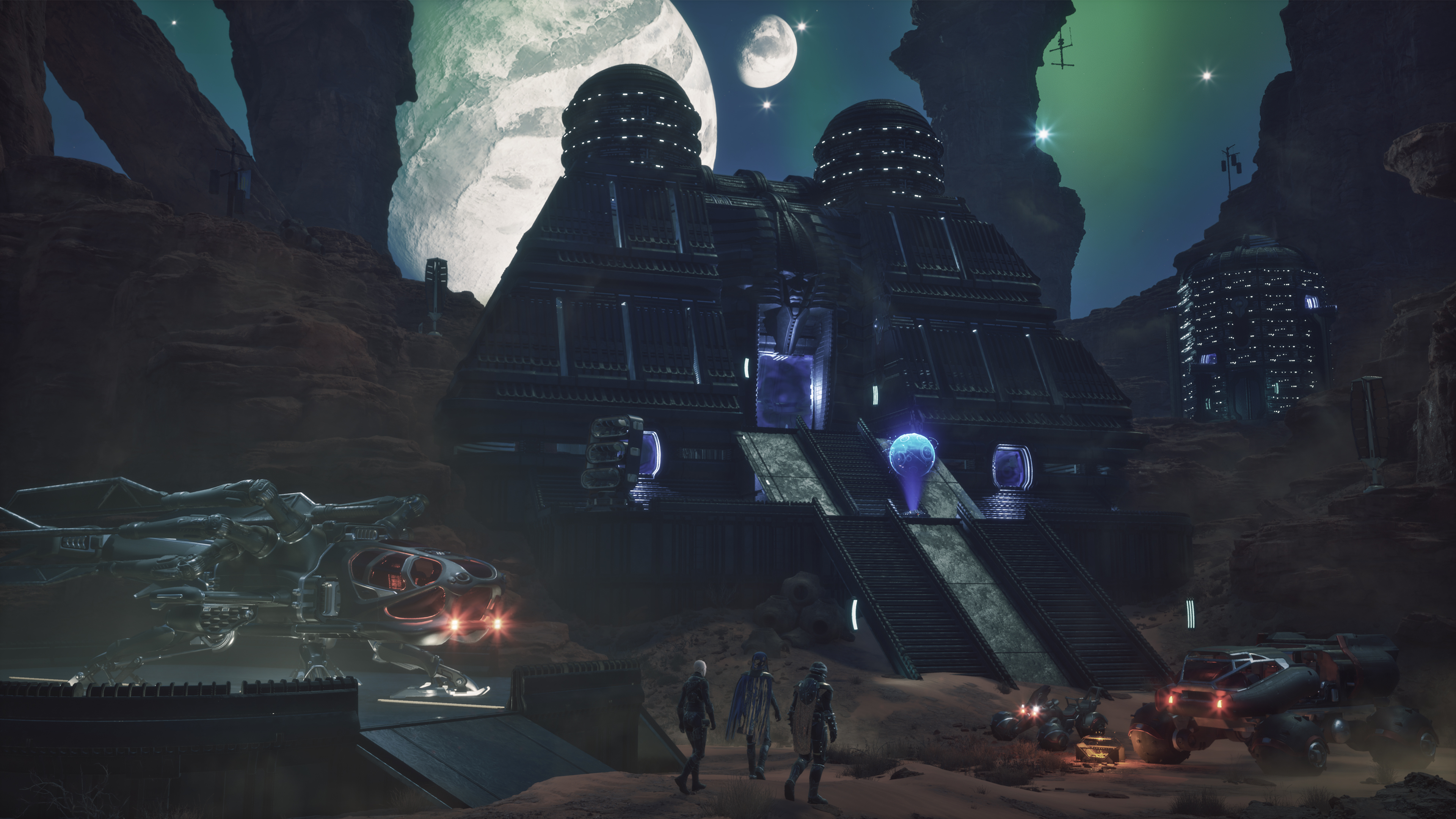




Building in Dune: Awakening – Claim Your Piece of Arrakis
Greetings Sleepers,
In Dune: Awakening, you will claim your part of Arrakis and build your base on it, from small shelter to mighty stronghold. You will build it piece by piece, from foundation to interior decoration. You will even choose the architectural style you prefer.
Building is an essential part of your survival and rise to power on Arrakis. Today, we will give an overview of building - how to claim your piece of Dune, build your own unique stronghold, and much more.
See the building in action in our building video showcase, and read on for a deeper dive.
There are two core purposes to building: expressing yourself by creating your ideal base, and becoming more powerful by developing your crafting capabilities and safely storing your gear and resources. You can invest as much as you want into either of these activities, spending your time building striking marvels, or creating a powerful and efficient spice refinery. You can of course also do both.Claiming Your Piece of Arrakis – Shields, Taxes, and Power
A base must be built on solid land because in the open desert, the roaming sandworms will inevitably destroy it. This still leaves ample space for you to choose where to place your headquarters.
You start by placing a sub-fief console, where you can manage things like your base name and permissions, and view important information like shield status, power consumption and capacity, water, storage, storm alerts, and more.
When you place your sub-fief console, you claim the land around it, and you will see an outline of the area in which you can build. The area around your starter sub-fief console can’t be expanded, but when you learn to build an advanced version and place it in new regions of Hagga Basin, you can expand your land claim both horizontally and vertically by placing staking units. You can build huge bases in such expanded areas and construct imposing structures atop tall mountains.

Keep in mind that you can’t expand infinitely and your land claim can’t overlap with the bases of other players or NPCs or be too close to Imperial Testing Stations or trade posts.
You can have a total of three sub-fief consoles and a maximum number of two starter ones. As you advance, your starter bases will be of little use and can easily be abandoned in favor of building more advanced ones.
Your base is protected by a shield. Without it, it will eventually crumble and return to the sands. To keep your shield running, you need to produce more power than you consume. Also, your advanced bases will draw the attention of the Emperor, who will begin to demand taxes to keep your shield running. If you don’t pay the taxes, the shield goes down.
This is a way to make sure that bases are not permanent, so the number of bases doesn’t simply grow until there’s no space for new ones. The system aims to be lenient enough to let you play entirely at your own pace, while making space for new bases.
Architectural styles of Dune – Choosing Your Allegiance
To begin with, everyone has access to the building pieces provided by CHOAM (Combine Honnete Ober Advancer Mercantiles), a colossal commercial organization with a monopoly across most of the known Universe.
After you have gained a foothold on Arrakis by acquiring better gear, learning powerful abilities from the Schools of the Imperium, and making a name for yourself, you can align with one of the Great Houses vying for power on Arrakis – House Atreides and House Harkonnen.

Should you complete their initiation and gain their trust, you can get access to their architectural style. The look of these sets of building pieces reflects the values of their respective faction, and even let you flaunt your allegiance by raising their banners.
Will you choose the unyielding, regal Atreides architecture, with its falcon motifs and shapes, or the dark chitinous Harkonnen style, oozing with menace and excess.
These are not entirely cosmetic differences. For example, only the Atreides have the lofty, wing-like balconies, while the Harkonnen boast uniquely tall, slanted walls. A looming face protrudes from above the gate, ever watching those coming and going.

In addition to the building pieces, you will have access to a wealth of interior decorations, also in various styles. Take your pick from warm Atreides rugs, organic, insectoid Harkonnen lamps and desks, the cold efficient shelves of CHOAM, and much more.
Customization and the ability to live your Dune fantasy are core pillars of Dune: Awakening. Therefore, after the game launches, we plan to expand the number of architectural styles based on the many factions in the Dune universe, with new building pieces and decorations.

Blueprints and Solido Projections – Co-op Building Made Easy
At any point, you can use your Solido Replicator to copy an entire base into a Blueprint, which is stored as an item in your inventory. You can then use it to place a Solido Projection of your base all at once but at a different location. You still fill in each building piece and need the required materials, but the Blueprint is there for you to follow.

Blueprints, like any other item, can be given to an ally, or even sold on the Exchange. If you’re architecturally inclined, why not make money doing it?
Solido Projections can also be used without using a Blueprint, by creating a base projection piece by piece. This is a great way to build with other players, since the projection is visible to everyone with access to your base. It’s easy to set up, change, and fill in.
Blueprints are invaluable for setting up a base fast, which can be the difference between life and death in the Deep Desert, where deadly sandstorms tear flesh from bone.
The Deep Desert and PvP
The Deep Desert is vast, deadly, and home to the most valuable resources, such as the spice. Maximize your production by setting up a forward operating base as a fortified hub from which to transport resources back to the relative safety of your main base behind the Shield Wall in Hagga Basin.
However, everything in the Deep Desert is temporary. Every week, the great Coriolis Storm sweeps across the huge map, changing the very landscape. Bases are reduced to dust, resources and points of interest, like the entrance to underground testing stations, are buried under the sand, while new ones are uncovered. The entire Deep Desert map is wiped, so make sure to get your resources out in time.

The Deep Desert is not subject to Sardaukar policing in the way other areas of Arrakis are, meaning that PvP is entirely possible. In certain limited circumstances, bases can even be raided there. Bases are invulnerable while their shields are up but there are three ways in which a base’s shields can go down in the Deep Desert:
- A player’s base lacks power.
- During and shortly after a regular sandstorms there is a small window in which the shields go down.
- Deep Desert Coriolis Storms also bring down shields as they are building up, which can take a few hours. This window is longer than regular storms, but it is also far more dangerous, given that once the Coriolis Storm arrives in full force, it will destroy all bases and kill anyone in the Deep Desert.
- Note: We mentioned earlier that failing to pay Imperial taxes will also lead to losing your shield, but Deep Desert bases are not taxed by the Emperor and therefore do not have this requirement.
Overall, creating a base in the Deep Desert is a choice - one that raises the stakes, so be conscious of the possible risks and rewards.
You Are the Architects of Arrakis
Dune: Awakening is a multiplayer survival game on a massive scale. It is also a sandbox where you, the player, have the power to affect the world around you, to build and to destroy, befriend and betray.
When you travel across the desert, the presence of others is apparent: a base nestled under the shadow of a cliff; another spearing the sky on a mountain peak; even their bodies, victims of the devastating sun, wither away in the sand. You will make your mark, too.
In Dune: Awakening, we have worked hard to make building as fun, easy, and impactful as possible, balancing functionality with freedom. We can’t wait to see what you will create on Arrakis. Your Arrakis.





